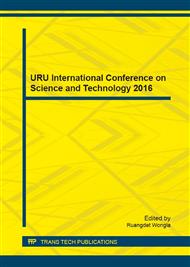[1]
G. Nelson, Microencapsulates in textile coloration and finishing, Rev. Prog. 21 (1991)72-85.
Google Scholar
[2]
R. Dubey, C. T. Shami, U. K. Bhasker, Microencapsulation Technology and Applications, Defence Sci. J. 59 (2009) 82-95.
Google Scholar
[3]
S. K. Ghosh, Functional coatings and microencapsulation: a general perpective, Wiley-VCHVerlag GmbH, Weinhein, (2006).
Google Scholar
[4]
M. S. Slavica, B. Dejan, S. Petar, Microencapsulation in the textile industry, Chem. Ind. Chem. Eng. Q. 12(1) (2006) 58-62.
Google Scholar
[5]
R. N. S. C. Teixeira, Microencapsulation of Perfumes for Application in Textile Industry, in: Doctoral dissertation, University of Porto, (2010).
Google Scholar
[6]
R. Kumari, S. B. Agrawal, S. Singh, N. K. Dubey, Supplemental ultraviolet-B induced changes in essential oil composition and total phenolics of Acoruscalamus L. (sweet flag), Ecotox. Environ. Safe. 72 (2009) 2013-(2019).
DOI: 10.1016/j.ecoenv.2009.02.006
Google Scholar
[7]
X. C. Liu, L. G. Zhou, Z. L. Liu, S. S. Du, Identification of insecticidal constituents of the essential oil of Acoruscalamus rhizomes against Liposcelisbostrychophilabadonnel, Molecules. 18 (2013) 5684-5696.
DOI: 10.3390/molecules18055684
Google Scholar
[8]
B. Marongiu, A. Piras, S. Porcedda, A. Scorciapino, Chemical composition of the essential oiland supercritical CO2 extract of Commiphoramyrrha (Nees) Engl. and of Acoruscalamus L., J. Agr. Food Chem. 53 (2005) 7939-7943.
DOI: 10.1021/jf051100x
Google Scholar
[9]
P. K. Mukherjee, V. Kumar, M. Mal, P. J. Houghton, In vitroacetylcholinesterase inhibitory activity of the essential oil from Acoruscalamus and its main constituents, Lett. Planta. Med. 73 (2007) 283-285.
DOI: 10.1055/s-2007-967114
Google Scholar
[10]
C. Suryanarayana, C. K. Rao, D. Kumar, Preparation and characterization of microcapsules containing linseed oil and its use in self-healing coatings, Prog. Org. Coat. 63 (2008) 72-78.
DOI: 10.1016/j.porgcoat.2008.04.008
Google Scholar
[11]
A. H. Conner, Urea-formaldehyde adhesive resins, in: Polymeric Materials Encyclopedia 11, CRC Press, New York, 1996, pp.8496-8501.
Google Scholar
[12]
L. Yuan, G. Liang, J. Xie, L. Li, J. Guo, Preparation and charaterization of poly(urea-formaldehyde) microcapsules filled with epoxy resins, Polymer. 47 (2006) 5338-5349.
DOI: 10.1016/j.polymer.2006.05.051
Google Scholar


